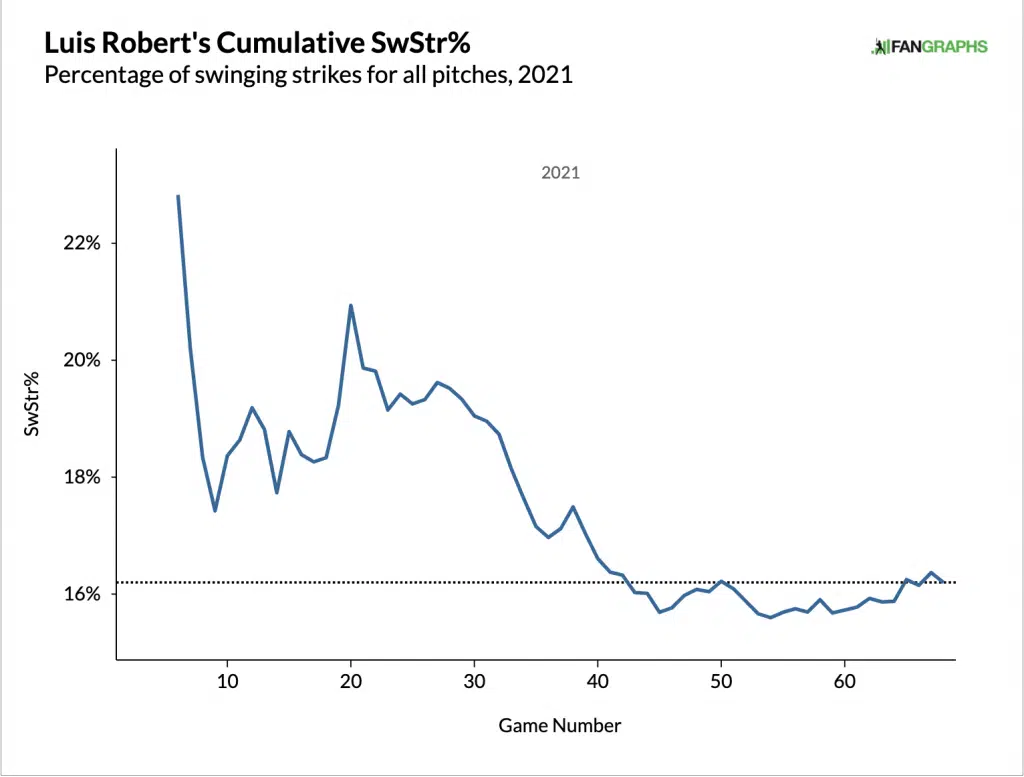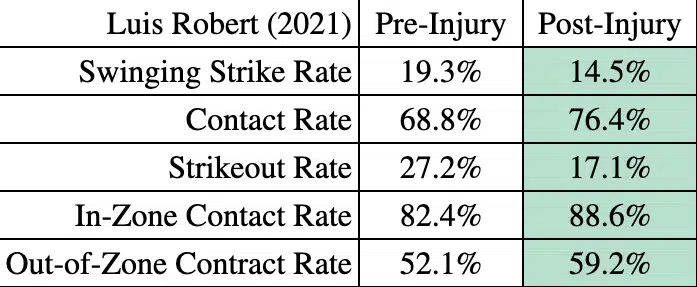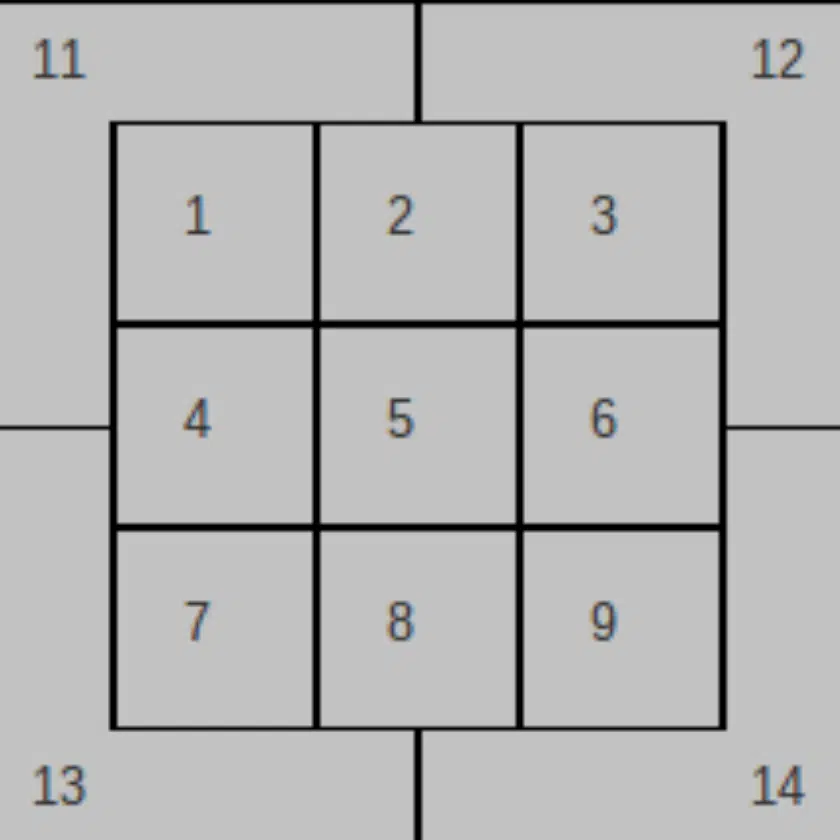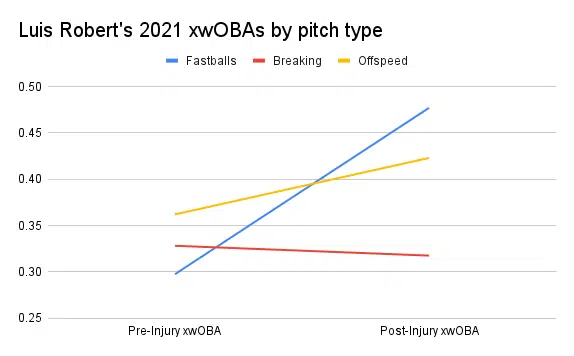Luis Robert is, understandably, receiving 2022 AL MVP hype following his enormous impact in 2021 after his August return from his torn hip flexor. Robert used his recovery time to refine his batting stance and approach, which makes his 2021 season a tale of what are essentially two different players at the plate. In order to determine whether the MVP hype is warranted, it is important to separate Robert’s outputs before and after his injury to gather insights about whether his performance could be sustainable.
Background
Overall, Luis Robert hit .338/.378/.567 across 68 games with a .946 OPS, 157 wRC+, and a .399 wOBA for the White Sox in 2021. As his .375 xwOBA might suggest at a quick glance, Robert hit very well in 2021, but could have been slightly aided by luck. I would argue, however, that his season needs to be completely split into two parts given how different of a hitter he was after his injury.
Pre-injury, Robert hit .316/.359/.463 over 25 games with a .822 OPS, 125 wRC+, and a .352 wOBA. His xwOBA over this span was .321, however, which is roughly league average and correlates with a ~101 or so wRC+. The eye test backs this up: early-season Robert was a very good player overall, but had little power at the plate coupled with unsustainable batted ball luck.
Granted, Robert will almost always appear as a “lucky” hitter from cursory looks at his statistics, as he does profile somewhat as an Anderson or Moncada-type of “sustainably lucky” due to his high exit velocities and elite sprint speeds. For example, the batted ball below had a 10% chance of being a hit, but Robert’s speed makes him capable of this becoming a hit more often than not.
Nevertheless, it is impossible to deny that Robert’s 2021 season before his injury was indeed influenced by batted ball luck. For every “lucky” play that actually was a result of Robert’s speed, there is one like this, which had a 15% chance of being a hit, but happened to find a hole.
Following his return from injury, Robert opened his stance noticeably wider and hit .350/.389/.622 across 43 games with a 1.011 OPS, 173 wRC+, and a .424 wOBA. Over this stretch, however, his .416 xwOBA implies that his performance on offense was only negligibly affected by luck, and the extremely small variation between wOBA and xwOBA can perhaps be explained away by Robert’s speed.
A Deeper Dive
Of course, Statcast metrics are just a few of dozens of tools available to separate luck from sustainable production in baseball. They happen to be some of the most consistent from my experience, but it is still difficult to suggest that Robert is bound to hit like the best player in baseball over the course of a full season in 2022 just because he did so legitimately for 43 games (47, including playoffs) at the end of 2021. As Robert’s changes to his batting stance were likely an attempt to get better timing at the plate, read pitches earlier, reduce his swing-and-miss, and get his barrel to inside and/or high fastballs, we can both look at more direct before/after statistics and analyze some video as well.

First, we can see that Luis Robert’s swinging strike rate plummeted as the season progressed — especially around the game #26 mark, which represents Robert’s return from his torn hip flexor.

The general swing-and-miss improvements Robert made before and after his injury are quite striking. Not only did Robert significantly reduce his strikeout rate, but he also made more contact when he swung at pitches both inside and outside of the strike zone. While it might be a stretch to completely attribute this to his refined batting stance, a further look can show why the tweaks were impactful and answer more questions about the sustainability of Robert’s production.
As mentioned, I suspect that one of the reasons for Robert’s post-injury adjustments was a desire to get his barrel to pitches — primarily fastballs — on the inside and/or high parts of the plate. Specifically, I focused on fastballs in zones 1, 4, and 11 in the below chart.

Before the injury and adjustments, Robert’s stats against fastballs in zones 1, 4, and 11 were:
.133/.133/.133 with a .266 OPS, .117 wOBA, and .133 xwOBA
After returning and against fastballs in the same zones, Robert hit:
.407/.484/1.000 with a 1.484 OPS, .599 wOBA, and .559 xwOBA
Those are not typos — Robert was absolutely putrid against high and inside fastballs before his stance changes, but was absurdly good against them afterward. As the polar opposite xwOBAs imply, this is not an example of extremely good or bad luck, but a truly profound change in production. Before I continue, I should address a question I had when I originally gathered these figures — why does Robert have a 77 point difference between batting average and on-base percentage in these zones considering pitches in zones 1 and 4 are strikes, and Robert walks fairly infrequently?
The answer is largely that the sample sizes for these figures are small (46 fastballs in these zones before the injury, 78 after), so they are skewed heavily by hit-by-pitches (such as above) or walks.
With that out of the way, it is clear that Robert was a different hitter against inside fastballs after returning from his injury. Below is a video of Robert against an inside sinker in April of 2021:
Now, here is a video of Robert against an inside sinker four months later:
Even though Robert does not appear to start his swing earlier in the second clip, his open hips enable him to utilize his elite bat speed to get his barrel to the inside pitch. It is not a one-size-fits-all approach, but it clearly clicked for Robert, whose stance actually became slightly wider as the season progressed.
Robert’s post-injury success, however, was not solely predicated on his meteoric increase in production against inside fastballs or his improved contact rates. In fact, Robert improved against offspeed pitches as well. And while Robert’s performance against breaking pitches was slightly worse than it was before his injury, the difference is very minor and could be explained by pitchers attacking him differently upon realizing his improvements against fastballs in the strike zone. Nevertheless, as illustrated earlier, Robert’s strikeout rate and contact rates improved across the board, as his open stance and altered leg kick empowered him to lock onto pitches earlier and stay with them later, making it easier for him to identify pitch types while simultaneously making him less susceptible to sliders low and away.

Takeaways
It was very difficult for me to find statistical red flags when it comes to the sustainability of Luis Robert’s offense. The only potential issue I could find was that his performance against breaking pitches lags behind his dominance against fastballs and offspeed pitches. However, it is actually quite normal for a player to have his worst production against breaking pitches, and it should also be noted that Robert’s .324 overall xwOBA against breaking pitches in 2021 was well above the league average of .270. Given these facts, I am really not too concerned about pitchers successfully force-feeding Robert sliders and curveballs this season.
Aside from obvious considerations such as the small sample or need for good health, I hope that I have proven that the risk of Robert failing to reach expectations at the plate this season is not centered around any sort of unsustainable batted ball metric. Pitchers and hitters are in an eternal battle of adjusting and counter-adjusting, and there is always a risk of pitchers figuring out a new way to consistently get Robert out until he can counter-adjust. Yet, this is a universal issue, especially for young hitters.
It will be vital for Robert to either maintain or improve on his developing plate discipline and contact skills. Ideally, his new stance and approach will guarantee this. On that note, Robert’s post-injury performance somewhat mirrored the 2019 breakout of Yoan Moncada. Moncada essentially sacrificed deeper counts and walks for more outcomes based on balls in play. The philosophy was sound: up to that point, Moncada posted elite exit velocities, but suffered from high strikeout rates and mediocre power numbers. By ensuring that a higher percentage of his plate appearances would end with a ball in play, Moncada was maximizing the ceiling on the range of his potential outcomes. As Moncada and Robert have similar contact profiles, the parallels in plate approach are also striking.
Of course, Moncada is a much more patient hitter than Robert, who has more game power than Moncada. Moreover, Moncada has since reverted slightly to increase his on-base aptitude while still providing much better overall output than he did in 2017 and 2018. I will be keeping a close eye on Robert’s walk and strikeout rates in 2022 to see if he continues on his 2021 path, or tries to find more of a medium.
MVP?
As offensive output is typically the most important factor in MVP voting, Robert’s production will need to meet or exceed his 2021 figures. His 157 wRC+ in 2021, if replicated over a full season, would certainly garner MVP consideration, but is just a notch below the outputs from some of the league’s elite hitters such as Bryce Harper (170) or Vladimir Guerrero Jr. (166). However, Robert’s 173 wRC+ after his return from injury was #1 in the AL over that span among players with 180 or more plate appearances (if you lower that threshold, the leader would actually be Yasmani Grandal [209]).
As mentioned, I struggled to find any reasons to believe that his production at the end of last season was unsustainable, aside from typical baseball concerns such as adjustments or injuries. As crazy as it may sound, given Robert’s age and immense talent, he could also get even better. While he has played far too few games at such a high level to be in the same tier as a Trout or Soto, the very reason he is in the preseason MVP conversation for 2022 is because many expect him to reach that status quickly. A more consistent power stroke from Robert could catalyze an even greater ascent. After all, as much as we had overwhelming expectations for Robert entering 2021, wouldn’t it have sounded a bit crazy to predict a .338/.378/.567 (.946 OPS, 157 wRC+, .399 wOBA) season, even with the missed time?
Obviously, MVP awards are not all about offense (even if they often tend to skew a little too much toward it). In general, the player needs to be on a good team, which should not be an issue for Robert. It helps if the player is at least passable on defense, and Robert’s Gold Glove play at a crucial position in center field gives him a massive advantage over a more traditional slugger like Vladimir Guerrero Jr.
Finally, plus speed certainly cannot hurt, and while Robert is one of the fastest players in baseball, he has been fairly cautious to this point in his MLB career when it comes to stealing bases. If he can increase his stolen base output even marginally, Robert will have yet another advantage over most of the AL’s elite players. My primary concern in terms of competition is Shohei Ohtani, as Robert’s substantial value does not extend to the mound.
Most importantly, Luis Robert needs to stay on the field. The shortened 2020 season was not his fault, and he only missed four out of 60 games, but after appearing in only 68 games last year, a healthy season would go a long way in easing concerns about Robert’s long-term durability and toward the success of the White Sox. I would imagine most fans would agree that it would be better for Robert to “only” turn in, say, a 4 WAR, 115 wRC+ season if it meant that he plays 140+ games.
Summary
On a team loaded with young, high-ceiling talent, Luis Robert still transcends. It’s no wonder that he is a popular bet for the 2022 AL MVP. I decided to write this both to evaluate whether his 2021 season was carried by any sort of hidden luck and to temper my own expectations about his potential. Aside from some minor batted ball luck on grounders in April, all I found was even more reasons to be optimistic about Robert’s upcoming season. If he can stay healthy, I am confident that he will solidify his standing as the best player on the White Sox and one of MLB’s young superstars.
Featured photo: @MLBStats/Twitter
Follow us on social media @SoxOn35th for more!

The decrease in hitting breaking balls makes perfect sense to me and doesn’t necessarily have anything to do with how often the pitch is thrown. With his stance more open, it changes the swing path, enabling him to turn on inside pitches, but less able to drive ones that are low and away, like most breaking balls are. Fortunately, a large percentage of breaking pitches are also balls, so if he can work on his patience and pitch recognition, he can keep pitchers from relying on those too much and increase his OBP as well. I don’t necessarily want him to develop a selective approach as he (and some other Sox hitters, notably TA and Moncada) thrives on being aggressive, but forcing the pitcher to throw strikes and taking walks when they’re offered is what’s needed, along with a full season of health, for him to really enter the MVP conversation.
Well said, I completely agree.
Great work as always Nik. Very thoughtful and deep.